Publication
Article
Urology Times Journal
MIPS 2020: How did urologists fare with quality program?
Author(s):
Almost all clinicians avoided negative fee schedule adjustment in 2022.
Robert A. Dowling, MD, writes, "The mean final MIPS composite score for the entire pool of clinicians was 90.1."

Eligible clinicians are in the sixth performance year of the Quality Payment Program (QPP), and most participate through the Merit-based Incentive Payment System (MIPS). Common concerns about MIPS include perceptions that MIPS measures are more appropriate for primary care than specialty practices, that MIPS does not improve patient care, that the positive fee schedule adjustments have been modest, and that the program creates a significant administrative burden for participants.1 Some urology stakeholders have proposed legislative reforms that would more appropriately reward high performers in the program.2 The COVID-19
pandemic has had a direct impact on MIPS performance through policies invoked in 2020 and 2021 because of “extreme and uncontrollable circumstances”—most notably automatic reweighting of the Cost category and options for reweighting the Quality category. This has made it potentially easier to achieve high scores. Although the Centers for Medicare & Medicaid Services (CMS) provides individual feedback to participants, it is not clear to most how they perform compared to their specialty peers. CMS recently published provider-level data for the MIPS 2020 performance year3 (most recent year available) that reflects actual performance by clinicians, groups, and specialties. This article will examine urologists’ QPP (MIPS) performance in 2020 relative to other eligible clinicians and how this might be relevant for the future.
There were 704,331 individual clinicians in 86 specialties with a final MIPS score reported by CMS in 2020 (down from 719,244 in 2019). The mean final MIPS composite score for the entire pool of clinicians was 90.1. The data include 6321 individual clinicians identified as urologists (down from 6672 in 2019) with a mean final score of 89.0. There were 4966 (78.6%) urologists who achieved a score of 85 or greater and qualified for the exceptional pool vs 82.0% of all clinicians; these numbers are significantly lower than 2019, when the bar for exceptional performance was lower (75). At the other end of the performance spectrum, only 1.7% of all clinicians scored below the final score threshold for negative fee schedule adjustments (MIPS score of 45), including 26 urologists (0.4%). The performance metrics of some high-volume specialties are included in Table 1.
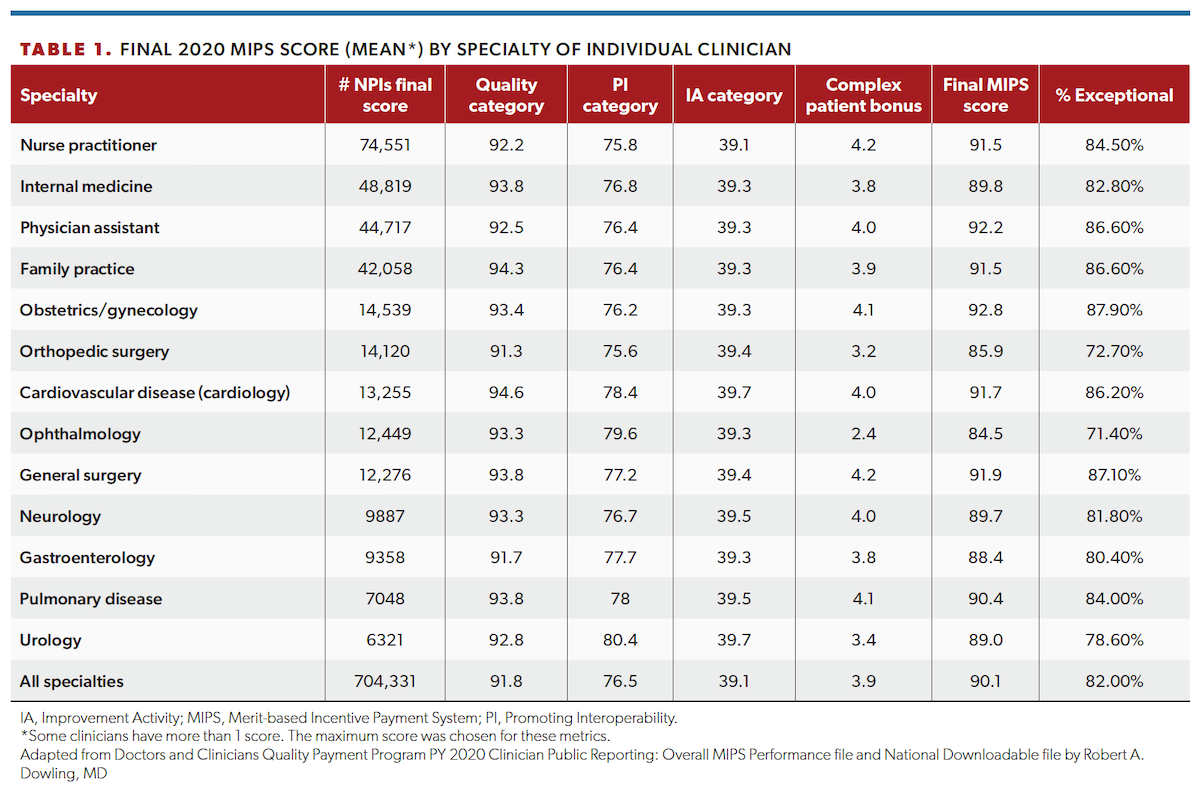
MIPS clinicians may report data as individuals, groups, via advanced payment model (APM) scoring, or combinations of these. Table 2 shows the breakdown of reporting sources for those urologists who earned a MIPS final score in 2020. Urologists subject to MIPS APM scoring had a much higher mean final score (97.1) than those eligible for group scores (87.6) or individuals (76.0), according to CMS data.
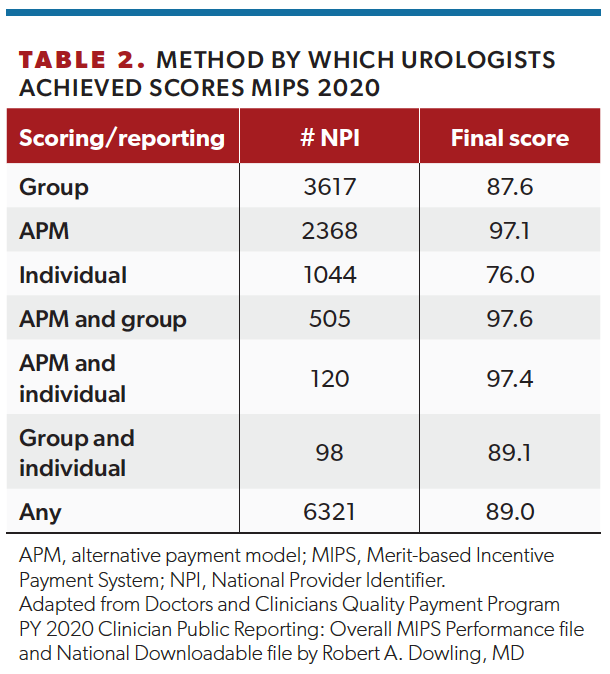
CMS also publishes measure level data in each of the categories. Table 3a shows the top 20 measures in the MIPS Quality Category reported by groups in all specialties. Urologists continued to use the same “generic” measures as other specialties in 2020 and underperformed other specialties in 13 of 20 Quality measures. To answer the concern that Quality measures are not relevant to specialties, CMS has introduced specialty sets that include, but are not limited to, specialty-relevant measures. In 2020, the Urology Specialty Set contained 20 measures. Table 3b shows the measures that were [group] reported in this set for all specialties and for urology. By 2020, urologists had not yet adopted many specialty-specific measures—perhaps because electronic health records (EHRs) and/or qualified clinical data registries had not yet been configured to report successfully on those measures.
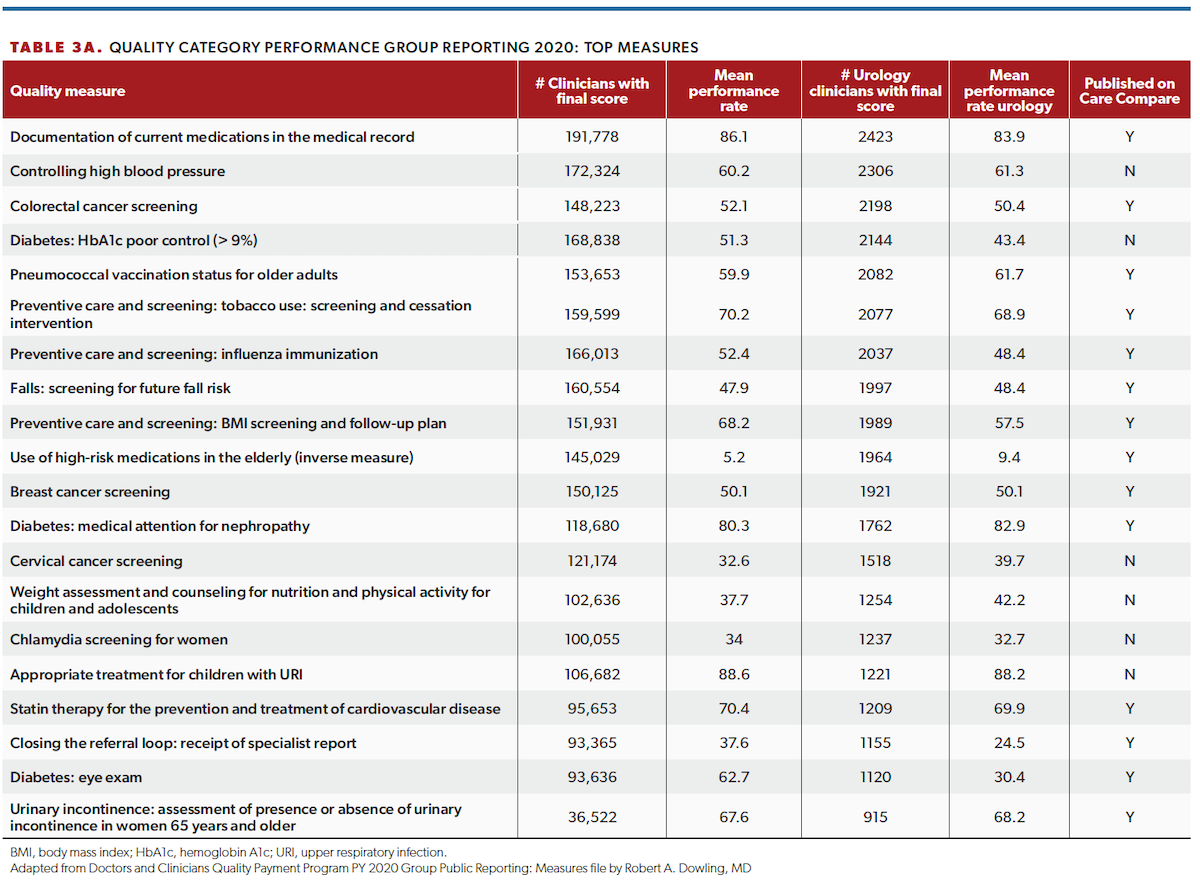
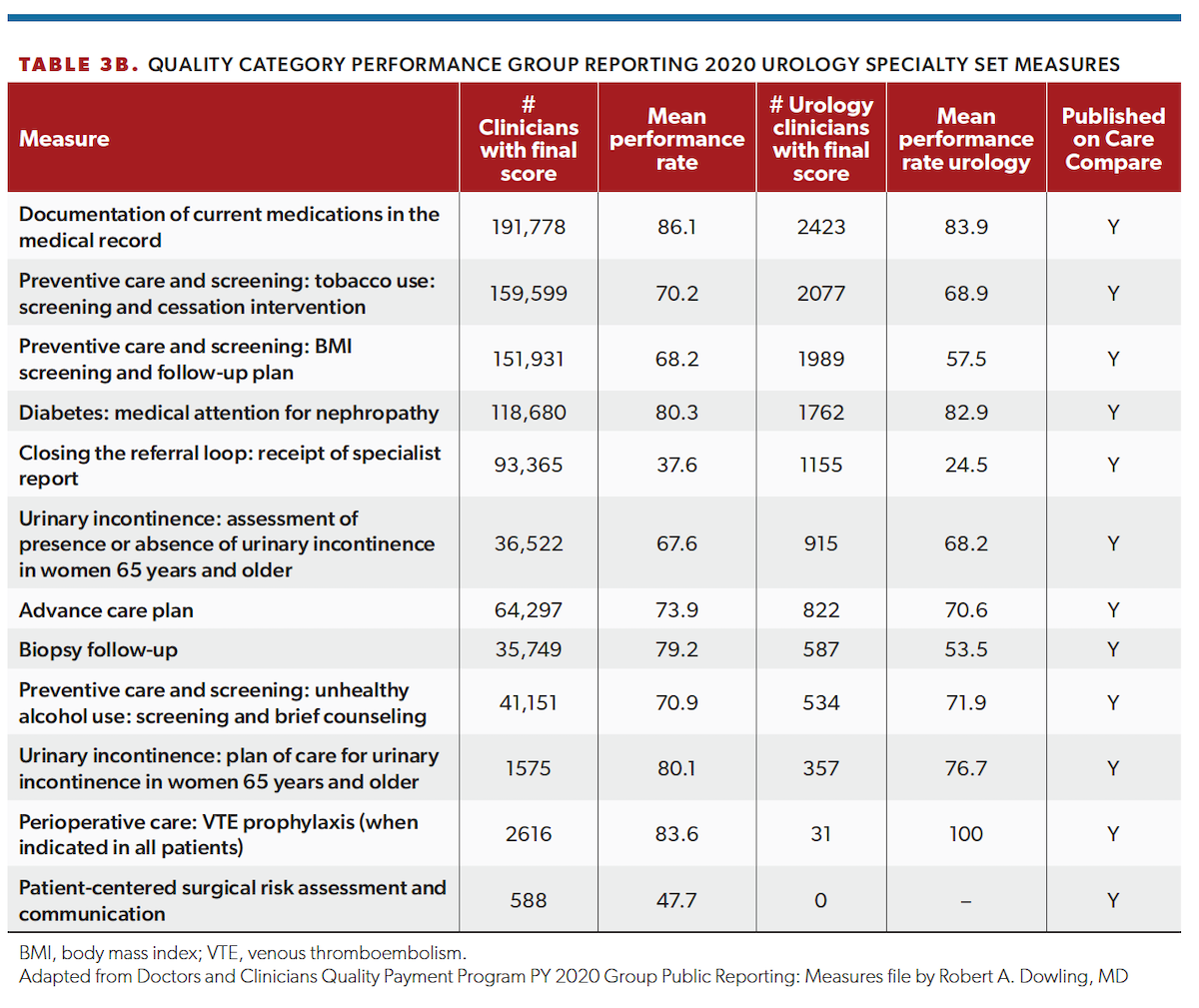
In the Promoting Interoperability category, urologists outperformed their peers in other specialties on e-prescribing and Provide Patients Electronic Access to Their Health Information, and underperformed relative to peers on Supporting Electronic Referral Loops (Table 4).The top improvement activity measures chosen by urologists were 1) Provide 24/7 access to MIPS-eligible clinicians or groups who have real-time access to patient’s medical record, 2) Engagement of patients through implementation of improvements in patient portal, and 3) Use of decision support and standardized treatment protocols. CMS did not publish measure-level data in the Cost category for 2020 performance year because of the automatic reweighting.
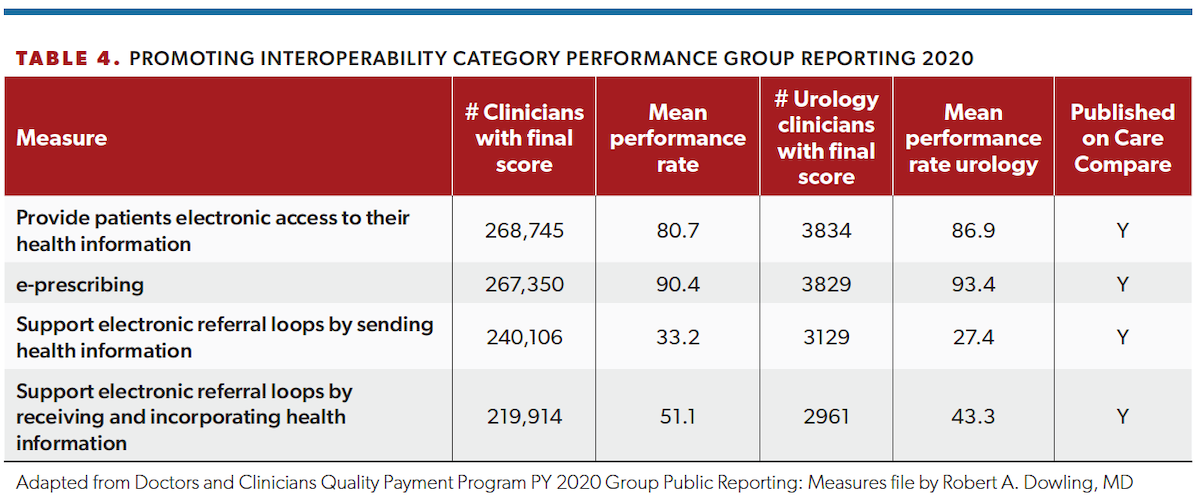
MIPS performance information is available on individual providers on the Physician Compare website (bit.ly/3meEZn9). In general, patients can view which improvement activities a physician attested to, and detailed performance on the Promoting Interoperability measures. Performance on a subset of Quality measures that meet certain standards is also displayed on the physician profile page (see tables 3a and 3b). The performance is displayed as a “star rating,” a value from 1 to 5 that is mapped to the actual performance score for that measure.
What does this mean for you and your practice? First, almost all clinicians in performance year 2020—like 2019—will have avoided a negative fee schedule adjustment (in 2022). The bar was lower in 2020 because of COVID-19–related adjustments in the program that allowed reweighting of categories. Almost 4 in 5 urologists qualified for exceptional performance in 2020, but this was a smaller amount than in 2019 even with the favorable category reweighting. As expected, it is getting more difficult to score well in MIPS and with inclusion of the Cost category making up 30% of the final score, bigger fee schedule adjustments may be seen in future years. Second, individual measure data provide a benchmark in the specialty for urologists to compare with other urologists and other specialties. Although urologists are doing well with e-prescribing and patient portal measures, there are opportunities for urologists to improve in supporting electronic referral loops—which may require involvement of EHR vendors and workflow redesign. True urology-specific quality measures were not mature in 2020 and will probably inhabit the realm of qualified clinical data registries (QCDR) in the future. If you have not done so, you should move toward using a QCDR for Quality measure reporting instead of relying on your EHR vendor for Quality measure updates. Finally, as the QPP matures, there is more information available to patients who are increasingly using tools like Physician Compare to evaluate their choices; if and when urology-specific measures become a reality, this information could be published and influence patient choices. The trend is sure to continue as we march slowly but relentlessly to “value-based care.” Urologists should view their own data on Physician Compare to understand the full arc of MIPS data, its current limitations, how it is displayed to the public, and how their patients may interpret this information.
References
1. Khullar D, Bond AM, Qian Y, O’Donnell E, Gans DN, Casalino LP. Physician practice leaders’ perceptions of Medicare’s Merit-based Incentive Payment System (MIPS). J Gen Intern Med. 2021;36(12):3752-3758. doi:10.1007/s11606-021-06758-w
2. LUGPA submits comments on MACRA reform. LUGPA. Accessed November 30, 2022. https://bit.ly/3FifL0h
3. Doctors and clinicians datasets. Centers for Medicare & Medicaid Services. Accessed November 30, 2022. https://bit.ly/3CZ9vqY

Newsletter
Stay current with the latest urology news and practice-changing insights — sign up now for the essential updates every urologist needs.




























